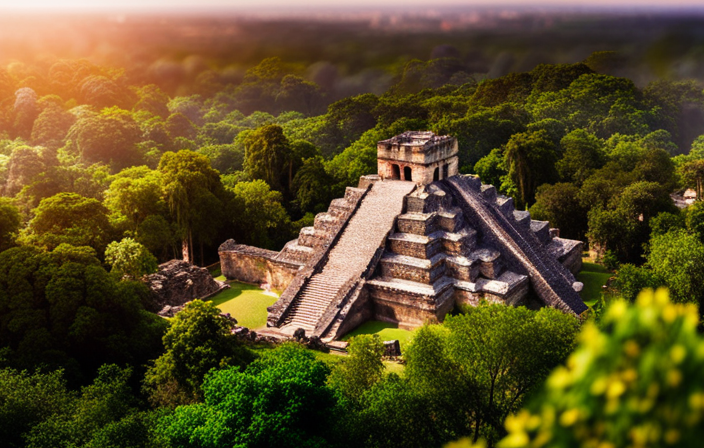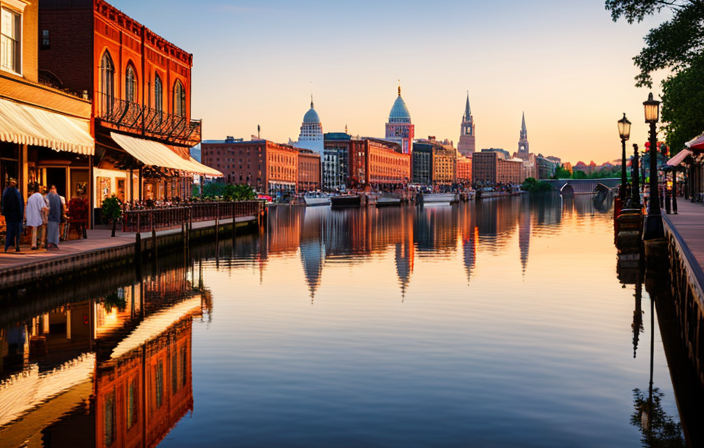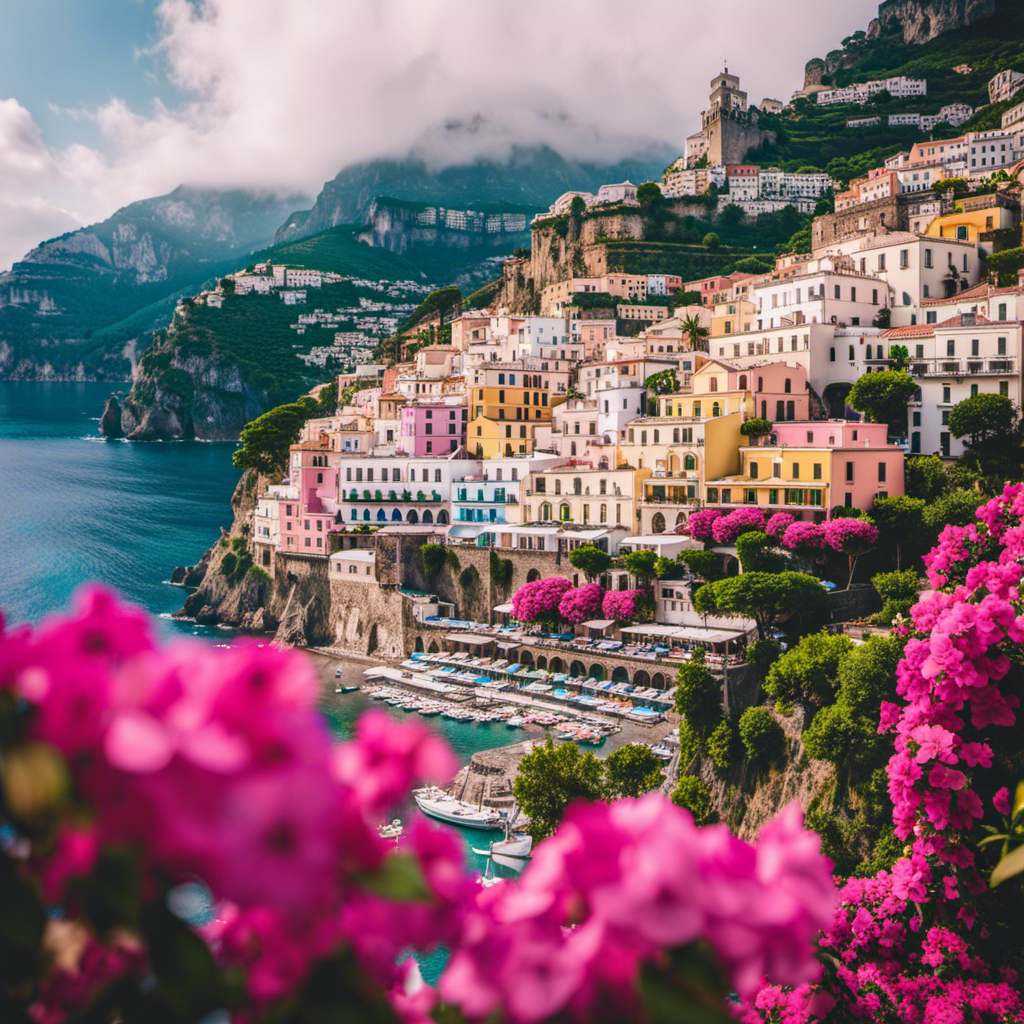The moment I stepped into the age-old city of Lamanai, its enigmatic allure instantly captured me. This vast metropolis, home to 35,000 souls in its heyday, holds mysteries that have fascinated archaeologists for ages.
Its towering pyramids, adorned with intricate animal representations, stand as a testament to its rich history. From its vibrant trading past to the eventual abandonment in the face of Spanish missionaries, Lamanai’s story is one of resilience and rebellion.
Join me as we uncover the mysteries of this remarkable city.
Key Takeaways
- Lamanai was a sprawling Mayan city that was occupied for over 2,000 years, making it the longest occupied Mayan site.
- With a population of approximately 35,000 residents, Lamanai was a significant political and economic center, as well as a trading hub with neighboring cultures.
- The city is rich in archaeological treasures, including highly decorated buildings with intricate carvings depicting various animals, especially crocodiles. These carvings provide insights into religious beliefs and mythologies of the Mayans.
- Lamanai’s temples, such as the High Temple and the Mask Temple, showcase the advanced engineering and architectural skills of the ancient civilization, emphasizing the ritual significance of reaching the top of these structures.
The Occupation and Size of Lamanai
Lamanai was occupied for over 2,000 years and had a population of approximately 35,000 residents, making it the longest occupied Mayan site and a sprawling city covering 960 acres.
As an archaeologist exploring Lamanai, I’ve made significant discoveries that highlight its cultural significance. The site is rich in archaeological treasures, revealing the advanced engineering and artistic skills of the Maya civilization.
The buildings at Lamanai are highly decorated, with intricate carvings depicting various animals, especially crocodiles. These carvings provide valuable insights into the religious beliefs and mythologies of the ancient Maya.
The cultural significance of Lamanai extends beyond its architectural wonders. The site’s long occupation and large population demonstrate its importance as a political and economic center.
Through my excavations, I’m uncovering the fascinating history of this ancient Maya city, shedding light on the cultural practices and traditions of its inhabitants.
Trading History and Abandonment
When the Spanish missionaries arrived in Lamanai around 1570 AD, evidence of trading with copper items from Central America and Mexico was already present. This suggests that the Mayans had significant contact with neighboring cultures.
The Spanish influence can be seen in the archaeological discoveries made at the site. Excavations have revealed artifacts such as Spanish coins and European ceramics, indicating the impact of colonialism on Lamanai’s trading network.
These findings shed light on the complex interactions between the Mayans and the Spanish during this period.
The exploration of Lamanai continues to uncover new insights into its history, allowing us to piece together the story of this ancient Mayan city and its interactions with the wider world.
The High Temple of Lamanai
From the top of the High Temple, the panoramic view of Lamanai’s river trading center is breathtaking. The temple rises above the jungle at 108 feet, offering a commanding view of the geographical location that made Lamanai an important trading hub.
The architectural design of the High Temple is remarkable, with its steps placed far apart, requiring a submissive crawl. This design was intentional, emphasizing the ritual significance of reaching the top. Climbing the temple is worth the effort, as it provides a glimpse into the experience of ancient ceremonial leaders.
The High Temple is a testament to the Mayan civilization’s ingenuity and engineering skills. Its grandeur and commanding presence make it one of the most impressive structures in Lamanai.
The Mask Temple at Lamanai
I was amazed by the intricate and imposing masks that adorned the Mask Temple at Lamanai. The masks, standing at 13 feet tall, depicted human faces with crocodile headdresses, showcasing the rich cultural significance of the ancient Mayan civilization. The Mask Temple itself, although smaller than the High Temple, was a unique and impressive structure that left me in awe. To further understand the exploration techniques used by archaeologists, I have provided a table below:
| Exploration Techniques | Description |
|---|---|
| Excavation | Digging and uncovering artifacts and structures |
| Mapping | Creating detailed maps of the site and its features |
| Documentation | Recording and photographing findings and observations |
The Mask Temple holds immense cultural significance as it offers valuable insights into the religious and ceremonial practices of the Mayans. Its construction in the late 5th or early 6th century demonstrates the ancient civilization’s advanced architectural skills. Exploring this temple and studying its masks not only deepens our understanding of Mayan culture but also helps preserve and appreciate their rich heritage.
The Ball Court of Lamanai
The Ball Court at Lamanai offers a fascinating glimpse into the intense and violent Mayan sport that often resulted in the sacrifice of the losing team’s captain. The game rules in Mayan ball courts were quite unique. Players used their bodies to keep the heavy rubber ball, weighing up to 20 lbs, in the air without using their hands or feet. The objective was to get the ball through stone hoops mounted on the walls.
The symbolism of the losing team captain’s sacrifice in Mayan ball games was significant. It symbolized the ultimate sacrifice and served as a way to honor the gods. The Mayans believed that sacrificing the captain would ensure good harvests, prosperity, and protection from evil spirits.
The Ball Court at Lamanai stands as a testament to the Mayan’s dedication to their religious beliefs and their fervent commitment to their sacred sport.
Frequently Asked Questions
What Were the Main Sources of Trade for the Residents of Lamanai?
The main sources of trade for the residents of Lamanai were trade routes and economic activities. They traded copper items from Central America and Mexico, showcasing their connections with neighboring regions.
How Did the Spanish Missionaries Impact the Culture and Society of Lamanai?
The Spanish missionaries had a significant impact on the culture and society of Lamanai. Their conversion efforts led to religious syncretism and the burning of the church in open rebellion.
Are There Any Other Significant Structures or Buildings at Lamanai Apart From the High Temple and the Mask Temple?
Yes, there are other significant structures at Lamanai apart from the High Temple and the Mask Temple. The Jaguar Temple, Stela 9, and the Residential Complex are some examples. The residents of Lamanai traded with neighboring regions for resources like jade and obsidian.
What Were the Rules and Regulations of the Ball Game Played at Lamanai’s Ball Court?
The rules of the Mayan ball game played at Lamanai’s ball court were intense. Players used their bodies to keep the ball in the air, but losing team’s captain often faced sacrifice.
Are There Any Theories or Speculations About Why Lamanai Was Abandoned Shortly After the Rebellion Against the Spanish Missionaries?
There are various speculations about why Lamanai was abandoned after the rebellion against Spanish missionaries. The impact of the missionaries on Lamanai’s culture and society likely played a significant role in the city’s decline.
Conclusion
In conclusion, exploring the ancient Mayan city of Lamanai has been a fascinating journey into the past. The vast size of the city and its intricate buildings reflect a thriving civilization that once flourished here.
The trading history of Lamanai sheds light on its importance as a center of commerce. However, the city’s abandonment following the arrival of Spanish missionaries is a poignant reminder of the clashes between cultures.
Standing amidst the towering temples and ornate masks, one cannot help but feel a sense of awe and wonder at the resilience and mystery of this enigmatic city.










